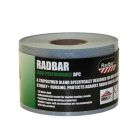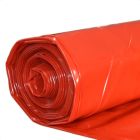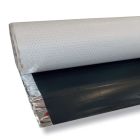Help & Advice Articles, Videos and How-to-Guides
Filter Articles
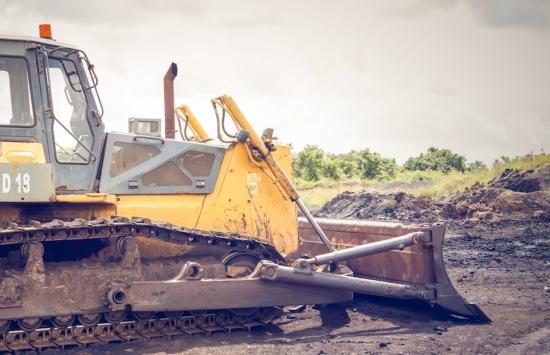
Gas Membrane Installation – How to Guide
The idea that harmful, invisible gases may be entering a home is a scary one. If you are building a new property, extending your home or having your basement converted, you need to consider the potential risks of radon and other ground gases.
In many areas radon gas isn’t an issue, but in some locations, it can pose a significant risk. To protect new build properties from ground gases like radon and carbon dioxide, you can install gas membranes.
In this guide, we provide some background information on ground gases, the gas barrier options available and instructions on how to install gas membranes in a property.
Protection from Ground Gases
Ground gases is a term that refers to gases found across the UK and Ireland in the spaces that exist around soil particles (pore spaces). These gases include radon, carbon dioxide, carbon monoxide and methane – all of which are asphyxiants (meaning that they can result in suffocation). They also pose other health risks including cancer.
These gases can occur naturally or be a result of contamination of the land such as on brownfield sites, old mine workings, or landfill sites where waste has been buried.
In low volumes, these gases do not pose a significant risk. However, if you are building properties on gas-contaminated land, then you need to provide protection from these harmful gases.
It is essential to first determine the ground gas risks of your site – this can be through a site inspection and gas monitoring in some instances. When it comes to Radon, you can use this radon map from Public Health England to get an indication.
Radon
Radon is an invisible radioactive gas that forms when the tiny amounts of uranium in rocks and soil decay. It is found everywhere, but at varying levels. Radon can cause health issues, including increasing the risk of cancer in certain instances. Some areas of the UK have a greater chance of high radon levels and new build properties in these locations need protecting.
Carbon Dioxide & Methane
Carbon dioxide and methane are commonly found in rocks and soil. As highlighted by Geoff Card and Steve Wilson: “they are an integral component of the geochemistry cycle of the Earth.” The danger comes from a build-up of these gases or the sudden release of them. Methane also poses a further risk as it is flammable.

Photo by McKylan Mullins from Pexel
Gas Membrane Protection
When building on land where ground gases are present, it is essential to take steps to minimise the chances of gases entering a property. Building Regulations must be carefully followed. One of the most widely available options is gas membrane protection.
What are gas membranes?
Gas membranes are usually plastic sheet membranes that prevent ground gases from passing through them. They are ordinarily installed during construction and form part of the foundation design.
There are numerous manufacturers of gas membranes, providing several distinct types including radon barrier membranes, liquid gas membranes, self-adhesive gas membranes and gas DPCs.
Many gas membranes also double-up as damp proofing membranes, protecting properties from both gases and ground moisture. In cases where hydrostatic water pressure is expected, then a cavity drainage system should be installed.
How to prevent radon gas entering your home?
Most gas membranes when correctly installed by a professional and used in conjunction with a Radon DPC will effectively prevent radon from entering a home.
The other ways of dealing with radon in a home is to use a radon sump in solid and suspended timber floors. Positive Input Ventilation (PIV) systems can also be effective at removing low and moderate levels of radon in an existing home, but professional advice is always required.
Why use a gas membrane?
Gas membranes prevent ground gases migrating from the soil and into a property where they can accumulate and pose significant risks. As previously explained, ground gases can be harmful to health and therefore it’s important to avoid exposure to them. The installation of a gas membrane should feature in the foundation designs of a new build property.
When is a gas membrane required?
Gas membranes are required on all high gas risk sites. To determine the level of risk, you will need to access or commission a report. You can find more information in BS 8485:2015, which is the code of practice for the design of protective measures for methane and carbon dioxide ground gases for new buildings and extensions. It provides guidance on the following points:
- site investigation
- determining ground gas parameters
- identifying protective design solutions
Similarly, radon membranes / barriers are required in high radon areas. Data from the British Geological Society will let you know if an area is high risk. Their reports are based on joint BGS - Public Health England (PHE) radon potential data and comply with BR211 Radon: Guidance on protective measures for new buildings. Radon measurements can also be taken in existing homes to determine if remedial measures are required.
The installation of a gas membrane system should be considered for all new builds, extensions and conversions such as basement conversions.
How safe are gas membranes?
BBA-approved gas membranes are highly effective when installed correctly. They undergo rigorous gas membrane testing to ensure their effectiveness. The 1200 gauge radon membranes that we stock at Permagard are very robust with a high puncture resistance. This makes them suitable for construction. In normal circumstances, these durable gas membranes will remain effective for the lifetime of the building.
All rolls of the gas barrier membrane that we sell are uniquely labelled and registered, providing complete traceability. This means they can be installed with complete confidence, knowing that the membrane has been independently tested, certified and carries BBA and ISO9001 approval.
Gas Membrane Installation
It is essential that gas membranes and radon barriers are installed correctly, meeting all applicable building standards and regulations. Any mistakes or oversights could result in harmful gases entering the interior of the property.
Gas and radon proof membranes are designed to be installed in concrete ground floors, either above or below the slab. They should therefore be considered at an early structural planning stage. There should be a detailed design phase to any project on a high-risk site.
Gas membranes are suited to the following applications:
- reinforced cast in situ concrete floors
- suspended beam-and-block concrete floors
- precast concrete slabs
Radon gas barrier installation
At Permagard, we stock the radon membrane. Our gas barrier installation instructions relate to this membrane. When laying radon membranes, they should extend the whole of the floor and walls.
Important note: Radon gas barriers are not suitable for floors that are subject to hydrostatic pressure. You would need a cavity drainage membrane system in these instances.
Step One
Unroll the first membrane. Make sure that it is laid on a smooth surface or one that has been sand blinded to prevent any punctures. Inspect it carefully to make sure that there are no indentations or protrusions. You should also ensure the surface is free from dust or grease, and is completely dry.
Gas Membrane Jointing
It is vitally important that all joints are sealed including under wall sealing.
Step Two
Apply PermaSEAL Double Sided Tape 50mm from the edge of the membrane, leaving the protective paper intact. The tape plays a key role in creating a water- and gas-tight seal between membranes.
Step Three
Unroll the second membrane, overlapping the first membrane by 150mm. Ensure that both membranes remain dry and free from dust and dirt.
Remove the protective paper from the Double Sided Tape. Now apply pressure to the membrane to join the two membranes together.
Every joint between gas membranes needs to be made gas tight in this way with the double-sided tape.
Step Four
You can now use a single-sided tape to seal the top join of the membranes. This creates an airtight seal. It also stops the section of overlapping membrane from flapping up and the screed getting between the two sections of membrane.
Important note: If you have any pipework coming through the slab and the radon barrier sheet then you need to take further measures to ensure gas can’t escape. Cut a hole in the membrane as close to the size of the pipe as possible. When the pipe is in place, you can use top hat fittings over the pipes alongside gas tape to ensure a gas tight seal.
Protecting the gas membranes
You should always take measures to protect the radon membrane once it has been laid. Any puncture at this stage means that it is no longer gas-tight. Either cover the entire area with some form of temporary boarding or lay a floor screed straightaway.
Jointing Gas Membranes with Radon barrier tape
Permagard stock a range of tapes as described above. The below diagram shows the jointing of membranes using our gas tapes.
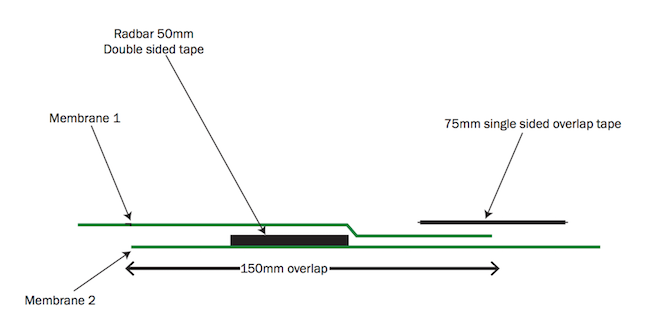
Floor and wall joints
All joints need to be gas-tight including the one between floor and wall, with particular attention paid to corners and including under walls and to gas DPCs.
Gas membrane detail
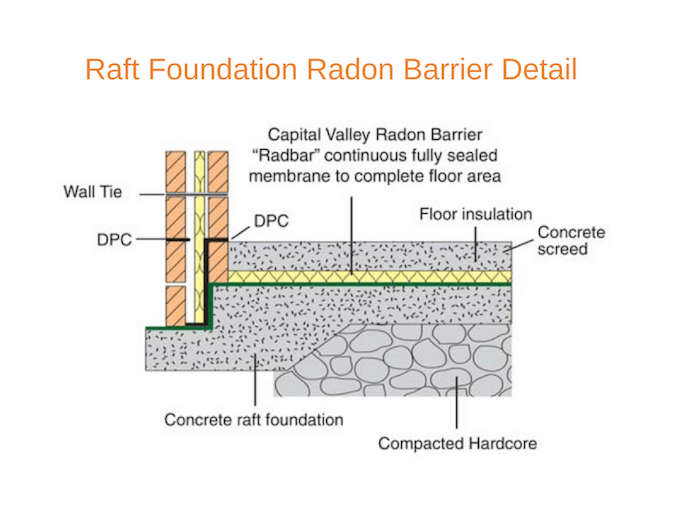
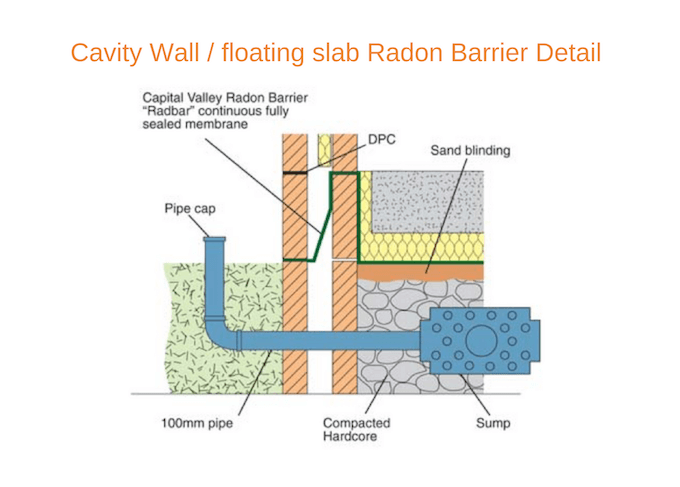
Important note: these gas membrane details are not working drawings. The final details are the responsibility of the designer, and will relate to your specific project.
Radon Barrier Installers
If you are looking for a radon barrier installer in your area, then your best bet is to seek recommendations from friends and local construction professionals that you trust. You can use websites like Checkatrade, Trustpilot, and REVIEWS.io to do some further investigation into potential radon barrier companies. It always makes sense to meet different installers and ask for a few quotes. This guide should give you an understanding of the relevant issues to discuss with them.
Ventilation, gas vents and gas protection systems
To install an entire gas system, you will need a gas membrane that extends across the entire floor and walls. You will also need to make provisions for ventilation, which helps prevent gas from accumulating beneath the floor. There are several ventilation options available, ranging from natural ventilation using a ventilation layer and airbricks, to mechanical systems such as fans.
It is worth consulting a professional around which option best suits your specific situation. A key component of these ventilation systems is a radon sump pump. It removes the radon gas from the property to a safe evacuation point, much the same as a basement sump pump.
For larger commercial and industrial units, you will need to install an active gas system. This relies on electromechanical elements to enhance the ventilation.
Gas Membrane Frequently Asked Questions
What is the difference between a radon barrier and DPM?
Essentially a radon barrier and a radon DPM (damp proof membrane) are the same thing. They both refer to plastic sheets that prevent the ingress of gas into a building.
The main difference between a radon barrier and standard DPM or damp proof membrane is that the latter only prevents moisture from the ground entering a property. They are both plastic sheets that are either installed under a new concrete slab or on top of it. Standard DPMs are only suitable in sites that are not a high gas risk.
How much do radon barriers cost?
Radon membranes are relatively inexpensive. At Permagard, we aim to keep our radon membrane prices low and the quality high.
There is a more comprehensive list of Radon questions covering both remedial radon protection and construction from the BRE.
Permagard – Gas and Radon Membrane Suppliers
As radon membrane suppliers, Permagard can provide free advice on gas membrane installation as well as gas DPCs. You can contact our expert team free of charge on 0117 982 3282 – they are always happy to share technical information and answer your questions.
Header Image credit: Image by Dapur Melodi via Pexel.

